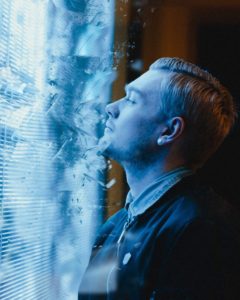The Architecture of Proximity
 My father’s lap, while he sat in his big white Lazy-Boy and taught, was a world all to its own. An exquisite sense of safety in every sense of the word, emotionally, physically, all while exploring different worlds of Torah, science, literature, and all sorts of new ideas, and, to borrow from the vernacular, a safe place to ask any question.
My father’s lap, while he sat in his big white Lazy-Boy and taught, was a world all to its own. An exquisite sense of safety in every sense of the word, emotionally, physically, all while exploring different worlds of Torah, science, literature, and all sorts of new ideas, and, to borrow from the vernacular, a safe place to ask any question.
It was a place I could share with Naomi without tension. We both experienced being in a rocket ship without any risk of finding ourselves, “Lost In Space.” We used that connection to make up adventure stories for each other as we walked to and from the bus stop.
The World of Pa’s Lap became a Succah as we told each other stories on the drive from Toronto to Baltimore for Succot.
It was while safely enclosed in this world I, half-asleep, heard mention of a soul as a home. The topic being studied was the Mishkan. I listened as my father challenged the students to match the different parts of the Mishkan to parts of the body, and from the body to the soul.
A student mentioned that the spiritual life as a palace was the subject of a book (Delices de l’Esprit) by Jean Desmarets. There was the Apartment of Faith, the Loge of Humility, the Prison of Nothingness. The palace explored by the hero, Philedon, was modeled on that of Cardinal Richelieu, and concluded, of course, with the Chamber of Love of Extension of the Faith.
The student mentioned that the spiritually loving Desmarets, eventually expressed his delights in his faith as the leader of the secret police of State and Church. “Rabbi,” she said, “I am less than impressed by those who can poetically create a Palace of the Soul.”
My father responded with a quote from Victor Hugo – with whom I was familiar from Children’s Illustrated Classics – “There is one spectacle grander than the sea, that is the sky; there is one spectacle grander than the sky, that is the interior of the soul.”
“Does the structure not reflect the soul that enters? The sections and vessels of the Mishkan were neutral, not good, nor evil. The soul that enters the Mishkan will find its reflection in the structure,” my father explained, “just as it does when it enters the different rooms of the Amidah, just as it does when it enters the Succah.”
- Great Minds Think Alike
In “Beyond The Wall,” I wondered whether it was possible during the second wave of COVID to use the Succah as a wall opener.
Debbie’s suggestions were, 1) Don’t be a Weinberg, and 2) Do not expect reciprocity such as gifts, flowers or bottles of wine from Succah guests. “No darling, not even peanut butter M&Ms!”
Don’t be a Weinberg:
Don’t find every reason in the world to be critical of others. Admire the Succot to which you may inexplicably be invited without finding all the problems.
(May I just add that my father would find an issue with a Succah and immediately figure out the Halachic reasoning of the host. He used the issue he saw as a way of increased connection with the host.)
Don’t expect reciprocity:
“Let the Succah reflect and be filled with the spiritual beauty you bring into it.”
Debbie doesn’t believe the walls of the Succah are barriers to others. She believes that whether the Succah is welcoming or rejecting reflects the souls of those who enter.
It seems great minds think alike:
World Famous Author Shiri Sher responded to Beyond The Walls with, “I like this one. I never thought about it like this. It’s like we decide what our walls will be. Separating or protecting? Will they be semipermeable, will they be rigid?”
The world-famous Pearnut commented, “You go outside every day (or often) to walk the dogs. Many don’t. Because of COVID, if I don’t have the kids, sometimes I don’t go outside. Sukkot removes barriers between people and nature. Removes barriers between False security inside and strong vulnerability outside. (Brene Brown style).
“Also the laws of nature. Like meeting spot between knowledge and imagination. Reminds me of the Mishkan, and a sukkah. The measurements don’t measure up… but it works in the end.”
Annie-Chana Elias: “Most people I have encountered are incredibly beautiful souls – all distorted and mucked up by experience that leaves them requiring walls.”
III. The Architecture of Proximity
I received a gift today from another great mind and soul, “Synthesizing Gravity; Selected Prose of Kay Ryan.”
The closing essay, entitled My House, begins with the author’s cat, Crispin, that uses her purring as a proximity indicator.
“This feeling about proximity is related to the exquisite force fields in a house. In the same way that the cat is made perfectly easy by a certain magical relationship between herself and the head of her person, a person is made easy by the magical relationship of various intersecting vectors generated by her chair and table in concert with her lamp, say.
“A house is a big skull or at least mine is for me – the container of my brain. Really, I move around in my house disembodied I’m sure.”
I have Succot on my mind, and many great minds (and souls) reminding me that the most powerful Succah is created by what I bring into it, The World of Pa’s Lap, a rocket ship with which I can explore worlds and ideas.
Now I have Kay Ryan urging me to experience my Succah as the container of my brain/soul, with gaps in the ceiling above that serve as proximity indicators of my connection to God and Creation.
If I use the walls to exclude others from my world and my life, the proximity indicator remains silent. The empty spaces in the s’chach are just that, empty spaces, in my roof, in my mind, in my soul.
Hili (I always seek) Mor adds: The Lulav and Etrog are Neshama detectors!



